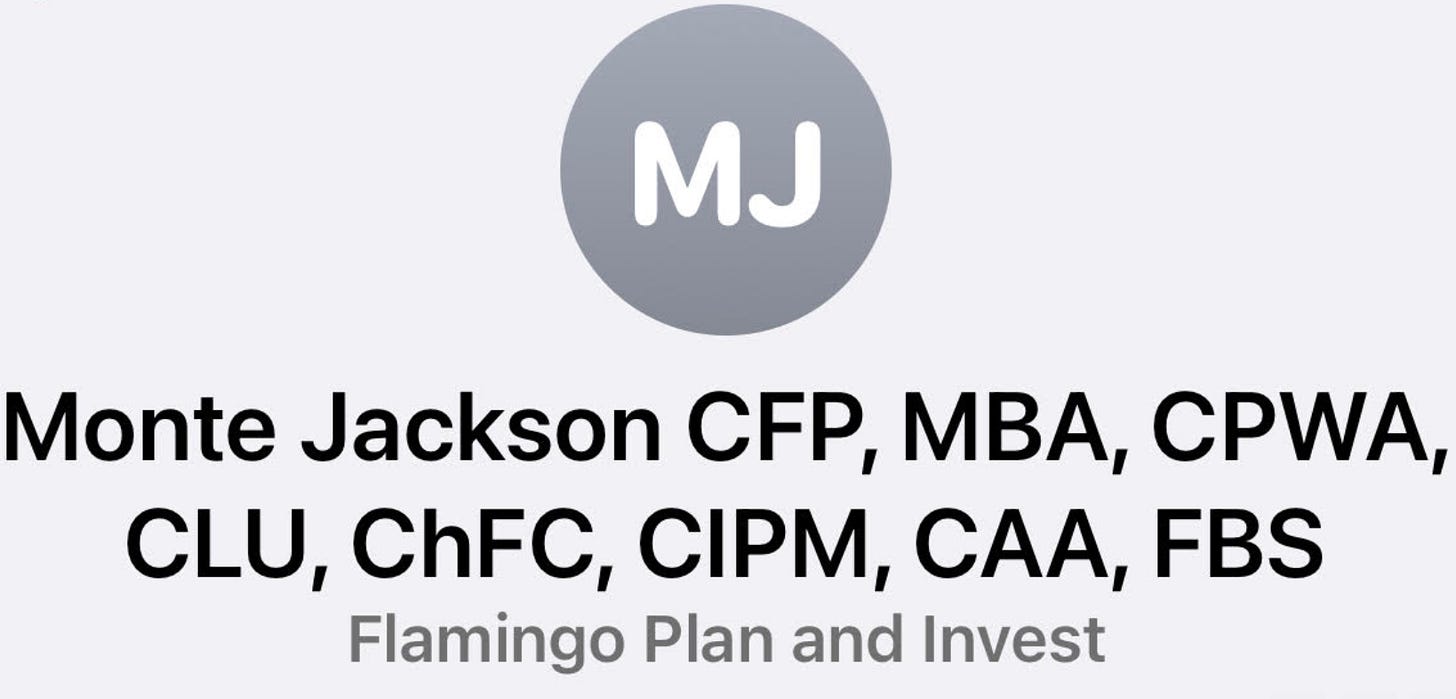Monte Jackson loves Flamingos. A financial planner and investment advisor, Monte created the Edina shop “Flamingo Plan and Invest, Inc.” and is always pushing his social media presence. A half-clad guy with a pink blow-up in the middle of a snowy field is memorable, but what does that have to do with financial planning? Not much. But that isn’t the point Monte wants to convey to his followers. Services and products sold among many suppliers require something different; Monte is just trying to get prospects in the door. He is constantly weighing shock value and competence.
One could argue Monte’s approach is short-sighted. A client, Diane Wetherly, offers an instructive example. While walking around the Mall of America with her friend Jenny, scrolling her Instagram feed, Diane says, “Jenny, look at this funny post.” “Who is that, said Jenny?” “Monte Jackson, my financial planner.” Laughing, Jenny thinks, “Her financial planner?” “Do you pay him?” It gets better.
Near the Nickelodeon Shop, Diane pulls up Monte’s contact information and airplays to Jenny the information Monte sent to her,
Jenny accepts and stares at the lit screen. Never has she seen so many degrees! Too much information and none of it makes sense. Pink Flamingo, half-naked guy, money, financial planning. What has Diane gotten herself into, she ponders. Oh, well. Always time to cull the contact list later; shopping is to be done.
Credential Overload
What do Monte’s degrees mean? You can classify them as certificates or continuing ed of a sort, but it is impossible for the average person to understand what they all mean from the listing. Clearly, someone like Monte didn’t go to Stanford because he would display that, too. Monte Jackson, Stanford ‘16, CFP, MBA, CPWA, etc. Everybody who graduated from Stanford lets you know within the first five minutes of a conversation, and surely it would have been Monte’s lead credential to promote his business.
Impressive? Maybe. Credentials are signals if the credential is recognized as credible. But it is hysteria. The listing takes a simple statement, “I am a competent financial planner,” and makes it scattered. If you ask Monte about them, you will think his lapel carries the financial decoration akin to an Iraqi war veteran. Monte in a professional, more serious moment: “I studied a lot.” “It shows I work more than many of my competitors.” Quantity is a marketing story. I’ll assert there is an inverse relationship between the number of professional credentials advertised and the financial care a customer receives. Quality is what the customer needs. Pause when a Monte calls on you. A college-educated, professional credential financial planner who is licensed as required by law should be good enough. But what professional credential is appropriate? Unfortunately, that is like the muddy mess of thawing snow on a downtown street.
Thank You Suzanne McGee
A recent piece by Suzanne McGee in the WSJ sheds light on the innumerable credential problem. There are too damn many. Suppose Flamingo man called on you. You wonder, what is a CIPM? If you happen to know about FINRA, sorry, the Financial Industry Regulatory Authority, you will find a list of credentials that investment professionals might carry. FINRA lists credentials with a disclaimer in all red: “Important Disclaimer: FINRA does not approve or endorse any professional credential or designation.” Go find CIPM, and you will notice that today, 133 credentials begin with the letter C. And that count is only the letter C. Certificate this and that, Chartered whatever, ……There is no standard.
FINRA loosely vets those credentials, through an application process, which implies a thumbs up when a credential is listed on its site. FINRA’s acceptance of an application for posting infers that a credential has a structure but leaves judgments about rigor and quality to others. Who are those who say the credential is worthy? That is one of the points of McGee’s piece. Financial planning is more than Flamingos. It is easy to imagine a planner pointing an inquisitive prospect to the FINRA site to strengthen the credential’s signal.
What should be the content of professional education? It is three-fold.
The language of finance, the terms, definitions, and knowledge about financial institutions are a must. An understanding of investment vehicles, the value of diversification that extends to human capital and financial assets, and asset allocation are important components.
Know the decision tools. Corporations have decision tools for allocating their capital spending, hoping to choose profitable projects. Individuals and their planners do, too, and these principles are built on making personal, financial choices that lead to the highest possible living standard.
Enough background in tax and estate planning law to direct a client to other providers with expertise in these areas.
Finding a Financial Planner
If you are searching for a planner, how do you minimize the search costs? It is a challenge because the industry isn’t doing itself any favors. Credential mania, after all! Moreover, financial planning and wealth management have historically been the purview of product sellers. A couple of decades ago, they were known as stock brokers and insurance agents. Today, we live in a world of financial advisors and private wealth managers. Some certified financial planners (CFPs) have tried to break the mold by offering a straight fee-only service, but when commissions, or % of assets under management, or some other incentive exists that conveys a benefit to the firm and a cost to the client, there is a heightened potential for a client loss on the margin.
Financial planning services are needed, and their delivery costs are fixed, related to the financial problem to untangle. Paying a fee for financial planning advice plus a commission for a product purchase isn’t required today. The predominant cost a customer faces should be related to the competence and creativity of the planner. Not a product solution.
A Recommended Approach
Word-of-mouth endorsements about fee-only planners can be a good start, and a swift internet search by the words “fee-only financial planner” will yield results. Investopedia has an article on the topic. A CFP is a good add-on because it shows a planner was interested in the primary credential with brand value, plus the recipient passed the CFP Board’s exam. It isn’t required, though. I have yet to find any CFP curricula that bring to bear economic decision-making principles for the personal financial problems confronted by individuals and households. The CFP Board can adjust its educational requirements through exam prep and exam questions, and this would be a fabulous outcome. We will see.
In the meantime, here is what I would look for in my financial advisor/planner:
1. The planner holds a 4-year college degree from a good school.
2. The planner is fixed-fee and has at least 10 years of cumulative experience in accounting, finance, and financial planning positions. Acceptable is a lawyer with experience in wills and trusts who decided to start a financial planning practice. Ideal: a CPA with a law degree and experience in wills and trusts.
3. The planner understands economic decision rules exist for household financial planning, and they will use them on your behalf to guide choices.
4. The planner passes your interview. The planner needs to be able to explain financial planning at the client’s level. Trust your gut.
5. The planner has an in-house team that includes a CPA and an estate planning attorney or can offer specific recommendations. These professionals will be an added annual cost, and you will want to interview them, too. They should be happy to offer a 30-minute phone interview for free. Feel free to state, “Here is who we are.” “Here are the needs we think we have.” “How can you help us?”
Investment Advisors
Notably absent from the list is an investment advisor. Not required. The empirical evidence is convincing that active advising doesn’t beat the market and is relatively expensive. Engaging index investing is the reasonable path for households. Active trading and churning of investments should never come up in polite conversation. The meat and potatoes of investing decisions should be focused on broad market exposure with sensitivity to asset allocation appropriate for your risk tolerance while minimizing advisory fees.
To be clear, I do not think the average active investment advisor violates their fiduciary role. Nor do I think they should be avoided as a financial planner per se. If you hire a traditional investment adviser who is an active adviser or has some other incentive, such as a fee linked to a % of assets under their management. In that case, they need to offer an array of non-investment services at no additional cost. A fee-only planner can help you establish a brokerage account with a cash management feature at Fidelity or Schwab and you can self-direct investments with the occasional help from the friendly folks at your investment company’s 800-number. I always recommend Malkiel as supplemental reading.
In sum, investing is often focused upon but is just one component of a well-done financial plan. At the top is for an individual or household to make decisions to maximize their sustainable lifetime living standard with full consideration for the uncertainties inherent in the future. That can be done with the right planner who has the right education, training, and experience. A laundry list of credentials like Monte’s credentials is not required. Must admit that if my planner had such creative talent my curiosity would be captured.






Appreciate your time reading and share with all your colleagues. There is a lot of open space between self-directed and active investing and if I was building a business at a traditional investment company it surely would have to include product discussion. Golden handcuffs could be economic-based financial planning, too.
Glad it hit the right chord.